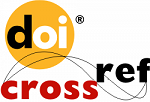Peningkatan Hasil Belajar dan Kemandirian Belajar Metode Statistika Melalui Pembelajaran Blended Learning
Abstract
This study aims to: (1) Know the differences in student learning outcomes between the Blended Learning model and ordinary learning both overall and based on the level of early math ability (high, medium and low), (2) Knowing the increase in student self-reliance taught by using Blended Learning models and students are taught with ordinary learning both overall and by the level of early math ability (high, medium and low). in this research use method that is quasi-experiment with pretest-postest control group design design. The population in this research consists of all 5th-semester students of Mathematics Education Study Program Universitas PGRI Palembang Academic Year 2016/2017. The sample in this research is class 5B (control class) and 5C (experiment class). Data collection with self-study test and questionnaire. Data analysis was performed using t-test statistic and t'-test. The result of the research shows that (1) the improvement of students' learning outcomes taught by using Blended Learning model is higher than students who are taught with ordinary learning both overall and based on the level of early math ability (high, medium and low), (2) improvement of learning independence students who were taught using the Blended Learning model were higher than students who were taught with ordinary learning in terms of overall, high and moderate levels of math skills, but not higher at lower levels.
Keywords
Full Text:
PDFReferences
Alfi, C., Sumarmi, & Amirudin, A. (2016). Pengaruh Pembelajaran Geografi Berbasis Masalah Dengan Blended Learning Terhadap Kemampuan Berpikir Kritis Siswa SMA. Jurnal Pendidikan : Teori, Penelitian, Dan Pengembangan, 1(4), 597–602.
Amin, A. K. (2017). Kajian Konseptual Model Pembelajaran Blended Learning berbasis Web untuk Meningkatkan Hasil Belajar dan Motivasi Belajar. Jurnal Pendidikan Edutama, 4(2), 51–64.
B. Sjukur, S. (2012). Pengaruh Blended Learning Terhadap Motivasi Belajar Dan Hasil Belajar Tingkat SMK. Jurnal Pendidikan Vokasi, 2(3), 368–378.
Bibi, S., & Jati, H. (2015). Efektivitas Model Blended Learning Terhadap Motivasi Dan Tingkat Pemahaman Mahasiswa Mata Kuliah Algoritma Dan Pemograman. Jurnal Pendidikan Vokasi, 5(1), 74–87.
Caporarello, L., & Iñesta, A. (2016). Make blended learning happen : conditions for a successful change process in higher education institutions. EAI Endorsed Transactions on E-Learning, 3(12), 1–8.
Dahar, R. W. (2011). Teori-Teori Belajar. Jakarta: Erlangga.
Ghiringhelli, C., & Lazazzara, A. (2016). Blended learning for developing effective virtual teams : a proposed intervention format. EAI Endorsed Transactions on E-Learning, 3(12), 1–13.
Hartfield, P. (2013). Blended Learning as an Effective Pedagogical Paradigm for Biomedical Science. High.Learn.Res.Commun., 3(4), 59–67.
Hermawanto, Kusairi, S., & Wartono. (2013). Pengaruh Blended Learning terhadap Penguasaan Konsep dan Penalaran Fisika Peserta Didik Kelas X. Jurnal Pendidikan Fisika Indonesia, 9(57), 67–76.
Jeffrey, L. M., Milne, J., Suddaby, G., & Higgins, A. (2014). Blended Learning : How Teachers Balance the Blend of Online and Classroom Components. Journal Of Information Technology Education : Research, 13, 121–140.
Kim, H. (2015). A blended learning scenario to enhance learners ’ oral production skills. The Eurocall Review, 23(1), 17–23.
Kirana, I. M. (2014). Pengembangan Konten Online Untuk Mendukung Blended Learning Pada Perkuliahan Kimia Kuantum Dasar. Cakrawala Pendidikan, XXXIII(2), 186–197.
Latifah, L. (2015). Inovasi Pembelajaran Akuntansi Berbasis Blended Learning. Jurnal Pendidikan Ekonomi Dinamika Pendidikan, VI(2), 222–232.
McGrath, A. L. (2014). Content, Affective, and Behavioral Challenges to Learning: Students’ Experiences Learning Statistics. International Journal for the Scholarship of Teaching and Learning, 8(2), 1–21.
Murni, D., & Romlah Noer Hodijah, S. (2016). Penerapan Blended Learning Berbasis Scaffolding Untuk Meningkatkan Kemampuan Berpikir Logis Dan Hasil Belajar Mahasiswa Pada Mata Kuliah Biologi Umum. Biodidaktika, 11(1), 45–51.
Ningsih, Y. L., & Jayanti. (2016). Hasil Belajar Mahasiswa Melalui Penerapan Model Blended Learning Pada Mata Kuliah Persamaan Diferensial. Jurnal Pendidikan RAFA, 2(1), 1–11.
Putra, A. P. (2015). Pengaruh Penerapan Model Blended Learning Terhadap Prestasi Belajar Siswa. Jurnal Candrasangkala, 1(1), 1–14.
Smith, W., Lewi, H., Saniga, A., Stickells, L., & Constantinidis, D. (2017). Bringing the Classroom into the World : Three Reflective Case Studies of Designing Mobile Technology to Support Blended Learning for the Built and Landscaped Environment. Journal of Problem Based Learning in Higher Education, 5(1), 64–84.
Sudjana, N. (2013). Penilaian Hasil Proses Belajar Mengajar. Bandung: Remaja Rosdakarya.
Syarif, I. (2012). Pengaruh Model Blended Learning Terhadap Motivasi Dan Prestasi Belajar Siswa SMK. Jurnal Pendidikan Vokasii, 2(2), 234–249.
Vernadakis, N., Giannousi, M., Derri, V., Michalopoulos, M., & Kioumourtzoglou, E. (2012). The impact of blended and traditional instruction in students performance. In Procedia Technology 1 (pp. 439–443).
DOI: http://dx.doi.org/10.24042/ajpm.v8i2.1633
Refbacks
- There are currently no refbacks.
Indexed by:

Al-Jabar : Jurnal Pendidikan Matematika is licensed under a Creative Commons Attribution-ShareAlike 4.0 International License.







